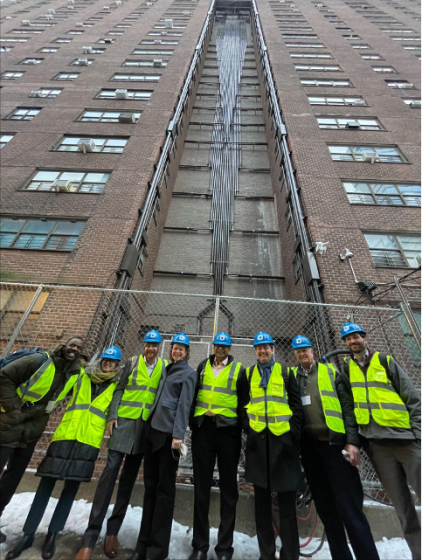DESIRED – Deep Efficiency and Smart Grid-Integrated Retrofits in Disadvantaged Communities
This pilot project will consist of new and existing multifamily affordable housing communities in diverse climates implementing a variety of decarbonization upgrades to help work toward zero net carbon operation while efficiently aggregating and increasing the availability of DERs to provide multiple grid services. A focus will be on disadvantaged housing communities that are able to respond to grid congestion signaling, grid carbon emissions signals, and increase the availability of renewable resources in energy markets through load shifting.
Project Lead
Electric Power Research Institute
Planned Location of Buildings
Seattle, WA and New York City, NY
Partners
Seattle City Light
Community Roots Housing
NYPA
NYCHA
GTI Energy
Neuro Building Systems
Vistar Energy
Community Roots Housing
NYPA
NYCHA
GTI Energy
Neuro Building Systems
Vistar Energy
Building types
600+ units in existing and new multi-family affordable housing
New or retrofit buildings
New and retrofit buildings
Energy Efficiency Target
30% of energy savings with the use of Wex Energy Solar Skins window inserts for low-cost scalable window retrofits, 120V Ephoca and Gradient heat pumps, use of Sanden CO2 and Daikin centralized heat pump water heaters.
Total load
N/A
DERs planned
More than 300 120V monoblock heat pumps, four central heat pump water heaters, six communities enabled with bifacial IEEE 1547 compatible Solar PV systems, one community with a centralized VRF system, one community equipped with cold-climate heat pumps, and two communities with fleet of V2G-enabled Electric Vehicle Supply Equipment (EVSE)
Flexible Loads
Targeting connected 120V monoblock heat pumps, connected centralized and unitary heat pump water heaters, managed community-scale EV charging
Coordinated Controls
The DER management will be coordinated through a data platform that combines customer service data, community energy systems, and grid conditions. The controls will focus on a tiered objective function that optimizes energy cost savings using an energy cost threshold approach for the customer, reduction of distribution grid congestion at the whole building level, and availability of more renewables for participation in energy markets in NYISO and CAISO at the portfolio of buildings scale.
Grid issues addressed
Distribution upgrade deferral and temporal congestion alleviation will be addressed along with improving energy market participation through a combination of energy efficiency and demand flexibility in this pilot using connected communities as local distribution resources with load shifting and DERs.
Grid services planned
This project will explore bulk system services and energy market participation in NYISO energy and CAISO imbalance markets through flexible load aggregation, load shifting, and optimal DER management. Managed bi-directional EV charging infrastructure will also be explored in coordination with flexible building loads for energy management.
Affordable Housing
The entire project is focused on affordable multifamily housing. The project covers 9 different communities between Seattle and New York with over 600 living units, and 2000+ residents involved.
DERMS
The project is using an EPRI-developed DERMS that works in two tiers – a local tier called LDERMS performs low-level DER-specific control actions and a higher tier (Utility Tier) called ADERMS performs orchestration and coordination of control actions across LDERMS instances. The LDERMS can be instantiated in the cloud but also on-premises. In the project, we are integrating LDERMS with Neuro Edge gateway to take advantage of Neuro Edge’s pre-established connectivity with Niagara controllers and Ephoca heat pumps and provide control actions that can be executed through Neuro Edge. ADERMS is hosted in the cloud and has a peer relationship with the Neuro Core (cloud software).
EV Charging
EV Charging is being considered in three communities, two of which are in Seattle at a smaller scale with up to six community chargers capable of managed charging. In NYC, we are adding V2G-capable EV fleet charging to include them alongside building loads as part of the VPP services.






